It might interest Martin J Cowling of the Wild About Travel weblog — who wrote an interesting article about getting to know your currency — that the euro is on its way to achieving parity with the dollar by the end of 2017, according to analysts at Goldman Sachs Group Incorporated as reported in this article by James Ramage of The Wall Street Journal.
The last time that the euro and the dollar were at parity was in 2002 — which is the year it entered circulation as a physical currency.
Martin wrote that if he could have his way, “the world would only have ten currencies (two per continent!). Easier to remember and less to carry! The reality is we have 180 currencies circulating amongst the 193 UN recognised nations from roubles, to lek to shekels, pesos and birr.”
Well, he may be getting “closer to his wish” in the form of the possible parity between the euro and the dollar; as well as the decline in the British pound in advance of the vote of whether or not Scotland should be an independent state — although if Scotland were to become independent, it is not clear as to which currency it will ultimately use.
It can be quite difficult to keep track of currencies. I will need to deal with at least six different currencies next month; and keeping track of exchange rates can drive one batty.
Even worse is attempting to find the best place to exchange those currencies. I tend to avoid airports; local banks usually offer better rates. I spend a limited amount of time — as little as possible — shopping around to exchange currency for the best deal.
If you are fortunate enough to be a customer at a bank which does not charge fees for exchanging currency or withdrawing money out of its network, you can use your automated teller machine – or ATM — card to withdraw funds in local currency.
Another tact is to use your credit card to pay — but be wary of any currency exchange fees you might be charged. Again, you are fortunate if you use a credit card which does not charge such fees — usually somewhere between two and five percent of the amount charged.
An interesting way to acquire currency is to pay for a meal with your companions with your credit card and have them pay their shares to you in cash. No fees are usually involved in such transactions; and you get the bonus of earning credit — whether it is a cash back rebate or frequent travel loyalty program miles or points — as a result. This is especially useful if your dining companions have too much local currency just prior to their trips home and want to get rid of it quickly without paying fees — and especially if you are not leaving the country you are visiting right away. I have done this many times — most of them resulting in mutually beneficial circumstances.
I always acquire a slight bit more currency than I need, as I collect the smaller denominations and keep them as souvenirs. The extra bills and coins can also be a nice gift to someone who is interested in foreign currency.
For currency exchange rates, Martin uses XE; whereas I use Oanda.
Please share your suggestions on how to keep up with currency exchange rates and get the most for your money. Thank you in advance.
